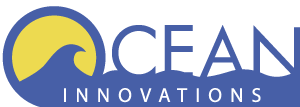ADCPs for Marine Renewable Energy Projects
APPLICATION: ADCPs — A versatile measurement tool for Renewable Energy projects
To support harvesting the marine environment for its renewable energy, instrumentation for measuring currents, waves, and tides must operate and survive in very dynamic environmental conditions for extended periods. For such conditions, the proven operational and performance advantages of the Acoustic Doppler Current Profilers (ADCP) become more valuable. This versatile tool provides a single device that can deliver a wide scope of water measurements (currents, waves, water level) required for the various stages of designing, installing, and operating a marine energy farm. In this overview, we mention several cases where these measurement capabilities of the ADCP have been used.
Versatile Tool
The ADCP is a sonar-based device. It uses a similar measurement method to the hand-held radars used in police “speed traps” or at sports events to measure how fast objects are moving. In this case, speed information in several directions is desired so the signal or “ping” is emitted along four beams simultaneously (see Figure). Several aspects of the echoes provide information. As a result, the ADCP makes four different measurements at once.
- Speed and direction of water currents are determined from changes in frequency (or Doppler shifts) of the echoes compared with the transmitted signal. For each “ping”, these velocity data are obtained at many levels through the measurement range–a “current profile”.
- Similarly, echoes scattered by the seabed reveal the speed-over-ground in applications where the ADCP is moving. This bottom tracking information is used to remove the boat motion from the measured currents and to map the path followed by the boat.
- Like an echo sounder, the ADCP measures height or range to the scattering object (in the water column or the surface or seabed) from the elapsed time (after transmit) before the echo is heard.
- The distribution of suspended material through the measurement range (e.g, a mid-water plume) is described by the strength or intensity of the echoes. These data permit a 2-d image of the contents of the water column.
This range of data types used individually and collectively permits a single device to make a diverse range of measurements.
- 4-d boat surveys of current circulation patterns
- Time series of current profiles, which reveal changes in water currents over time and through the water column
- Directional array measurements of the surface wave field
- Instantaneous, tidal, and long-term variation in water level
This note considers how this range of capabilities in a single device can be applied in several different ways during the stages of designing and operating an energy farm.
Operational Advantages
What are operational advantages of this method compared with mechanical instrumentation? The ADCP uses acoustic signals that are scattered off suspended materials moving with the water. As a result, the ADCP can remotely sample many levels at once throughout a range of the water column while deployed in relative safety on the seabed. In addition, the ADCP has no moving parts. This makes it well matched to a highly dynamic environment, avoids the need for recurring calibration, and permits reduced maintenance compared with mechanical meters. The hardware is a compact, low profile, and robust package. It houses low-power electronics that permit long-term unattended deployments.
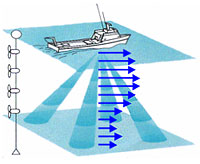
Good examples of these operational advantages stem from trials at the European Marine Energy Centre (EMEC) test site in Orkney, at the northern extremes of the United Kingdom. For measuring the wave environment, initial work used surface following buoys. After a storm event, two of these devices had been lost. A passing vessel destroyed another. Beneath the surface, conditions are equally demanding. Even bottom-deployed equipment has been swept away by strong tidal currents. These high drag conditions can also cause significant vibration problems for meters deployed in regular bottom mounts. In these waters, all deployments of Teledyne RDI’s ADCPs have been recovered. After adjustments to the bottom-mounting frame were made, high quality data sets of extreme current speeds have been recorded.
Operational Solutions
Design And Layout Of An Energy Farm
Whether the anticipated energy source is currents or waves, there is a need to collect information about the ambient environment when an energy farm is being considered. A key focus is the variability of the energy source—specifically how its magnitude and direction change in time and around the site, e.g. steering effects of bottom terrain.
In the East River in New York City, Verdant Power is installing a field of turbines to capture the energy of tidal currents reaching 4 knots off Roosevelt Island. As well as revealing the impressive speeds of these currents, the ADCP boat sections showed an asymmetric distribution of the currents across the river section, which will be key information for deploying the field of turbines.
A little farther to the north, the Cape Wind project is exploring a site for an offshore wind farm. Here ADCPs are being used for a yearlong study of the surface wave field. More than just wave energy, the ADCP provides a directional array capability. These data permit detailed analysis of how the wave energy and direction vary with wave period as well as over time. Further the ADCP can resolve waves of the same period arriving from different directions–a unique advantage compared with traditional wave sensors.
Once a field has been surveyed and generator sites selected, the same ADCP can be moored to collect time series of current velocity at many levels through the water column. This information can aid design plans about the depth levels for locating the turbines and how this might change with the direction or phase of the tidal cycle.
Tuning Performance of the Turbines
After an energy farm is installed, the same ADCP used for initial survey work can be employed for real-time monitoring of currents through the water column. For devices like the offshore tidal turbine “Seaflow” designed by Marine Current Turbines, which can reposition the rotor turbines through depth, this type of information can be valuable for tuning the performance of the system or avoiding depth layers where vertical shears might cause problems. In other cases, these real-time ADCP data might be used for tuning the pitch of the rotor blades as water speeds vary.
For systems that capture energy from both ebb and flood tides, like Engineering Business’s Stingray, which uses the flow of the tidal stream over a hydroplane, or Verdant Power’s, which uses a yaw system to rotate the turbines, real time current data from the ADCP can help choosing the best time to reconfigure the system. Real-time ADCP data can also aid in interpreting variability in the output of turbines or for knowing when to shut down if environmental conditions approach design thresholds. In a similar way, the suspended load observed with an ADCP might provide the basis for an alarm at sites where currents can stir up sediments storms that might degrade the operation of the turbines.
Another type of ADCP that provides interesting possibilities for operational energy farms is the Horizontal ADCP. This device can be deployed to look upstream to see the incident currents in front of the turbines without concern about hardware being sucked into the turbines.
Tidal Currents In ADCP data
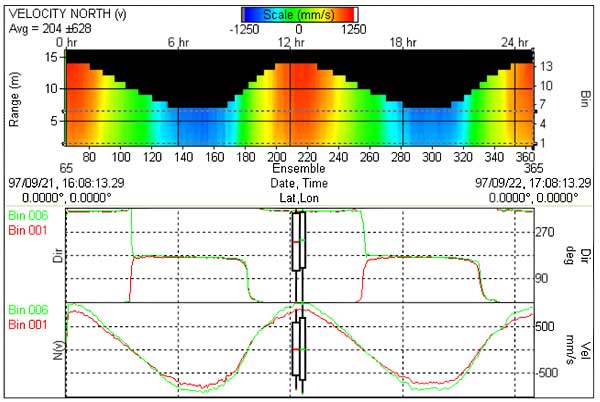
Time Series: These data from an ADCP deployed in coastal waters off France reveal a strong tidal regime over a 24h period. Northward currents are plotted in (1) upper color-contour panel showing the whole water column (2) lowest panel showing time series near bed (red) and at the low water level (green). Peak current speeds exceed 2.5 knots. Notice also the impressive tidal range of 25 ft. The mid panel describes flow direction at the near bed and low water levels.
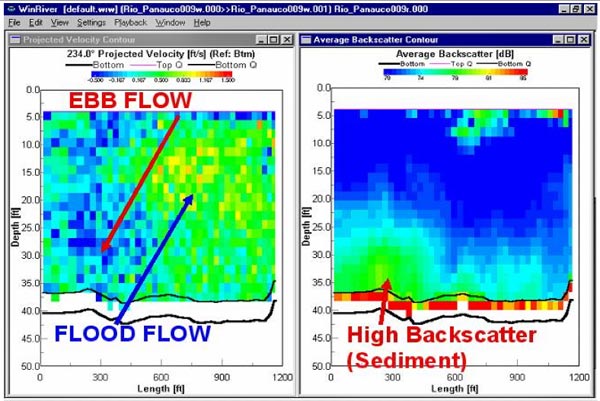
Boat Survey: These data from an ADCP boat survey in the Port of Tampico, Mexico reveal strongly asymmetric conditions during the turning of the tide. Also displayed is the ADCP echo intensity data that reveals clouds of suspended sediment.
Summary
The ADCP provides a powerful measurement tool that is well suited for the demanding conditions typical of sites anticipated for marine energy farms. This note has considered the versatility of ADCPs and how their diverse measurement capabilities might aid the various phases of surveying, designing, and operating a marine energy farm.
Appendix A
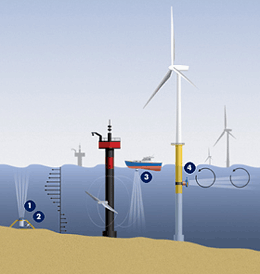
Teledyne RD Instruments’ ADCP Products
Teledyne RD Instruments offers a full family of ADCP products designed to collect highly accurate current and waves information for your offshore site assessment and/or ongoing monitoring needs.
- Teledyne RDI’s highly versatile Workhorse Sentinel can be deployed on the seafloor or within a surface buoy to collect high resolution profiles of the current speed and direction throughout the water column, providing you with a clear illustration of the currents at play. This instrument can be configured to collect and store data until the unit is retrieved, or can transmit data in real time to an offshore platform or shore station using a cable or underwater acoustic modem. The Sentinel can also be upgraded to include bottom tracking, which allows the instrument to be deployed over the side of a moving vessel for coastal survey operations.
- Teledyne RDI’s Workhorse Sentinel can also be upgraded to include a Waves Array. This upgrade allows you to collect both high resolution current information and multi-directional wave data, providing you with a clear understanding of these important physical elements impacting your site.
- Teledyne RDI’s Workhorse Mariner has been designed specifically for moving boat survey operations. The Mariner offers all of the benefits of Teledyne RDI’s traditional ADCP products in a compact package designed specifically for coastal hull-mount applications. The unit is easily integrated into the vessel’s DGPS input to provide integrated ADCP readings with precise position information.
- Teledyne 300 kHz long-range Horizontal Acoustic Doppler Current Profiler (H-ADCP) is a narrow beam acoustic monitoring system that “looks” out horizontally to measure near-surface water currents and multi-directional waves. This unit can be conveniently installed and powered from an existing offshore renewable structure.















